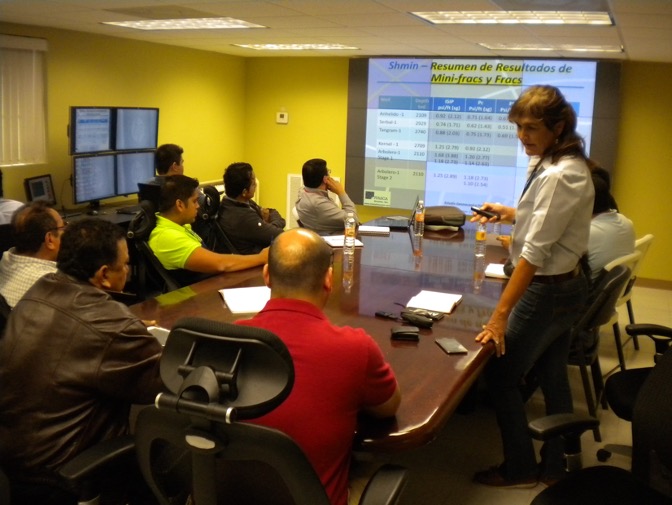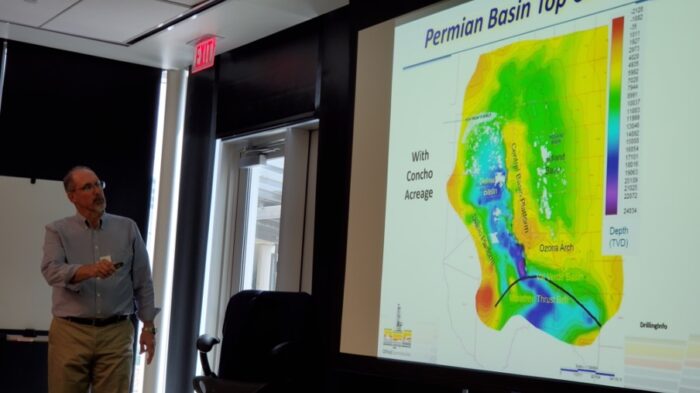Our course training philosophy has been, and will continue to be, that in-person training is the best means of conveying numerous, detailed engineering concepts in a time-efficient manner. Nonetheless, in keeping with the continuing world-wide health crises, our courses have gone on-line to support participants from their home offices in 2020, 2021 and Spring, 2022.
Regardless of our desires and plans, we continue to adapt to the particular needs of our clients. If an online course is desired, we are glad to provide this and have already tailored our course materials to fit an online format.
Besides offering courses directly, are courses are also currently available through RPS Nautilus, Geologica, SPE and ARMA.
| |
| I. Geomechanics for Managers – 1 day / OL: 1 session of 4 hrs |
| II. Geomechanics Data – 3 days / OL: 3 sessions of 4 hrs |
| III. Geomechanics for Unconventionals – 5 days / OL: 5 sessions of 4 hours |
| IV. Drilling & Completions Geomechanics for GGRE – 3 days / OL: 3 sessions of 4 hours |
| V. Geomechanics for Hydraulic Fracturing – 2 days / OL: 2 sessions of 4 hours |
| VI. Geomechanics for the Energy Transition – 1 day / OL: 1 session of 4 hrs |
| VII. Monitoring Techniques in Geomechanics – 2 days / OL: 2 sessions of 4 hrs |
| VIII. Geomechanics in Drilling Operations (Wellbore Stability) – 2 days / OL: 2 sessions of 4 hrs |



COURSE I. GEOMECHANICS FOR MANAGERS
Module 0. Introduction to Geomechanics
- A few words about Oilfield Geomechanics
- What is geomechanics? Definitions, history, relevance
- Petroleum vs. mining geomechanics
Module 1. Fundamentals of Geomechanics
- Introduction to the 4 components of geomechanics
- Stress, pressure, mechanical properties and geometry
- Effective stress concepts, role of pore pressure
- Field stress variations, structural effects
Module 2. Geomechanics in Drilling
- Stresses around a wellbore
- Basic concepts and causes of overpressure
- Wellbore failure
- Mud weight window
Module 3. Geomechanics in Hydraulic Fracturing
- Critical role of in-situ stress
- Complexity
- DFITs
- Role of rock fabric
Module 4. Geomechanics in Reservoir Development
- Critical role of formation pressure
- Stress-dependent permeability
- IOR/EOR geomechanics
Module 5. Geomechanics in Unconventionals
- Concepts and tools
- Myths and Magic
- Frac hits (FDI’s) and Casing Deformation
Module 6. Geomechanics Program Specification and Quality Control
- Defining the challenge
- ‘Nice-to-have’ vs. required data
- Questions to ask
- QC
COURSE II: GEOMECHANICS DATA
Module 0. Introduction to Geomechanics
- A few words about Oilfield Geomechanics
- What is geomechanics? Definitions, history, relevance
- The Geomechanics Model (1D vs. 3D)
- Geomechanics workflow(s) – 1D & 3D models
Module 1. Mechanical Property Data from Lab Testing
- Elastic, elastoplastic and viscous (time-dependent) mechanical properties
- Rock mechanics testing on intact core – UCS, Triaxial, block tests, drained vs. undrained
- Acoustic emissions; lab dynamic vs. field dynamic vs. static properties
- Anisotropic behavior
- Characterizing rock fabric – natural fractures, bedding planes and laminations; Direct Shear Testing
- Building data correlations and calibrating models with lab data
Module 2. Geomechanics Data from Wireline Logs
- Basic geomechanics logs – density and sonic logs
- Elastic dynamic properties from logs
- Dynamic vs static properties – converting with correlations
- Anisotropic behavior from sonic logs
Module 3. Geomechanics Field Data
- Drilling event data – pore pressure and stress indicators
- DFIT’s, mini-fracs, XLOT’s – design and interpretation
- Seismic inversion for elastic properties – calibration and key issues
- Field data as calibration for well integrity and reservoir compaction
Modules 4. Geomechanics Monitoring Tools and Methods
- Wellbore / drilling data
- Seismic data
- Microseismics
- Tiltmeters
- Fiber optics
Module 5. Model Validation with Field Data
- Incorporating field data in history matching
- Model updating
COURSE III: GEOMECHANICS FOR UNCONVENTIONALS
Module 0. Introduction to Unconventional Geomechanics
- A few words about Oilfield Geomechanics
- What is geomechanics? Definitions, history, relevance
Modules 1 – 2. Principles of Stress and Strain & Field Stress Measurements
- Basic of stress-strain and Mohr circles- applications on natural fractures
- Effective stress concepts, role of pore pressure
- Field stress variations, structural effects
- Stresses around boreholes
- Stress determinations
Module 3. Pore Pressure Evaluation
- Basic concepts and causes of overpressure
- Pore pressure analysis – Eaton, Bowers’, NCT, effective stress methods
- Analysis workflow
- Challenges in unconventional, field examples.
Modules 4 – 5. Mechanical Rock Behavior
- Mechanical properties, elasticity plasticity, poroelasticity, viscoelasticity.
- Failure in rocks, failure criteria
- Influence of faults and fracture, anisotropy
- Laboratory testing, measurements, interpretation
- Use of logs for mechanical properties, calibration, correlations.
Module 6. Geomechanical Modeling and Workflows
- Concepts and tools
- 1D, 2D and 3D models
- Geomechanics workflows in unconventionals
Modules 7 – 8. Hydraulic Fracturing Fundamentals
- Basic, objectives, parameters
- Frac containment, net pressure
- Injection testing, DFITs
- Horizontal wells
- Perforating, Proppants – 100 mesh and proppant transport,
- Fracturing fluids
- Role of natural fractures. Injection zone selection
Module 9. Stress Shadows: Single Frac & Multi-stage, Multi-well Effects
- Mechanics of stress shadows
- Effect on multi stages and clusters
- Multi-well stress shadows
- Tip shear stresses, Modeling examples
Module 10. Rock Fabric Characterization
- Description and quantification of rock fabric attributes – cores
- Mechanical behavior, hydraulic behavior, testing in unconventionals
- Stresses – critically stress fractures and hydraulic conductivity
- Geometry and spatial occurrence, DFN models.
- Examples of evaluation in unconventional plays
Module 11. Shale Geomechanics
- Unconventional shale plays – shale types – challenges, critical issues
- Geological scenarios for completions
- Geomechanics of interfaces – HF interaction with interfaces, effect of fracture toughness
- HF models: traditional and advanced models
- Shale properties static and dynamics examples from different plays – elastic parameters, time dependency, frictional properties
- Shale and Shale like behavior – mineralogic content, shale and flow.
- Myths to debunk – brittleness, complexity, SRV and microseismic, sand volume per lateral length
Module 12. Hydraulic Fractures (HFs) and Natural Fractures (NFs)- Operational Effects
- HFs propagation with NFs – effect of NF orientation
- Dual HF propagating in a fractured media
- Pressure Diffusion – coupled effects – stimulation benefits
- Interaction HF – NF – crossing rules.
- Influence of NF characteristics – Dense vs sparse DFN, stress anisotropy, NF connectivity, parametric studies. Modeling examples.
- Influence of operational parameters, effects of fluid viscosity, injection rates – injection time,
- Influence of the stress field and insitu pore pressure on HF behavior.
- Microseismicity response with anisotropic stresses – dry and wet MS events. Effect of initial aperture of the NFs.
Module 13. Depletion Effects & Refracs
- Depletion effects on HFs, depletion and in situ stresses.
- Parent -child evaluations, Cluster efficiency, drainage volumes
- Frac hits – types.
- Microseismic depletion delineation, Cube evaluations
- Refracturing – candidates, case histories, lessons.
- Geomechanics of refracs.
- Refracs economics, refrac activity, examples.
- Refracs methods, engineered refracs.
Module 14. Multi-well Completions
- Zipper fracs, stress perturbations, induced shear around zipper fracs
- Interaction of HFs, overlapping HFs, models
- Zipper fracs stress shadows.
- Effect of multiple well completion in fractured rock mass – sheared fabric – friction angle effect, geometry of zipper fracs. Effect on fabric stimulation.
- Sheared length, pressure diffusion.
Module 15. HF Monitoring and HF Models (extra session)
- Temperature Logs, strengths and weaknesses, procedures. Effect of wellbore and completion.
- RA logging procedures, strength and weaknesses, tracer applications
- Micro seismic monitoring – MS as a geomechanics issue. Events, field data, MS imaging, passive seismology, triggered or induced seismicity, array design, surface vs downhole, source mechanisms, SRV from MS and drainage volume.
- Tiltmeters- direct fracture monitoring, measurements, patterns, cases.
- DAS/DTS Basics, production estimations, cluster efficiency, integrated analysis.
- HF Models – advanced models fundamentals, input data, 2D models, pseudo (planar) 3D, Cell/Grid based models, lumped pseudo 3D, Fully 3D, HF reservoir simulators.
COURSE IV: DRILLING & COMPLETION GEOMECHANICS FOR GGRE
Module 0. Introduction to Drilling & Completion Geomechanics
- A few words about Oilfield Geomechanics
- What is geomechanics? Definitions, history, relevance
- The Geomechanics Model (1D vs. 3D)
- Geomechanics Workflow(s) – 1D and 3D model development
Module 1. Geomechanics Fundamentals
- The geomechanics model: stress, pressure, mechanical properties and geometry
- Basics of stress-strain (deformation)
- Effective stress concepts, role of pore pressure
- Lab, log and field geomechanics data
- Field stress variations, structural effects
- Stresses around boreholes
- Stress determinations
Module 2. Geological Scenarios for Drilling and Completions
- Stress regimes and in-situ stress variation with structural position; geobodies
- Geological models vs. a geomechanical model (“Mechanical Earth Model”)
- Drilling in tectonically complex environments (field examples)
- Hydraulic fracturing in shales and formations with rock fabric
Module 3. Role of Rock Fabric
- Defining geomechanics rock fabric
- Natural fractures, bedding planes and laminations: weak planes
- Rock fabric in drilling and completions
- Characterization of rock fabric from a Drilling and Completions view point: what is relevant and why
Module 4. Seismic and Petrophysics in Drilling and Completions
- Seismic-derived elastic parameters and calibration
- Seismic data and in situ stresses
- Petrophysics as a key tool in geomechanical characterization
- Correlations
Module 5. Workflows and Actions to Support Drilling & Completion Operations
- Drilling decisions and completions decisions that G&G and RE professionals can impact
- Coupled fluid flow and geomechanics analyses – key aspects
- Geomechanics in waterflooding
COURSE V: GEOMECHANICS FOR HYDRAULIC FRACTURING
Module 0. Introduction to Geomechanics for Hydraulic Fracturing
- A few words about Oilfield Geomechanics
- What is geomechanics? Definitions, history, relevance
Module 1. Geomechanics Fundaments
- Basic of stress-strain; effective stress concepts, role of pore pressure
- Field stress variations, structural effects
- Stress determinations
- Basic concepts and causes of overpressure; pore pressure analysis
- Mechanical properties: elasticity, plasticity, poroelasticity, viscoelasticity
- Failure in rocks; failure criteria
- Laboratory testing, measurements, and interpretation.
- Use of logs for mechanical properties, calibration, correlations
Module 2. Hydraulic Fracturing Basics: Fracture Mechanics Concepts
- Critical concepts – net pressure, tip shear stresses, fracture conductivity
- Fluid leakoff
- Fracture toughness and stress intensity factors
- Fracture propagation and fracture geometry – key drivers
- Viscosity-dominated vs. toughness dominated fracture propagation
- Injection test – concepts
- LOT setup and interpretation; XLOT concepts and value
- DFIT’s and mini-fracs
Module 3. Geomechanical Parameters and Their Influence on HF Propagation
- Role of in-situ stress
- Biot’s coefficient
- Elastic moduli
- Toughness
- Rock Fabric
Module 4. Fracturing Tight Sands vs. Shales
- HF design in tight sands – pressure signatures, HF optimization and HF modeling
- HF in shales – differences, rock heterogeneity, anisotropy and rock fabric
- Multistage HF; Stress Shadows
- Perforations – clusters and stages
- Proppant transport
- Landing location
Module 5. Hydraulic Fracturing in Formations with Rock Fabric
- Interactions between hydraulic fractures and rock fabric
- HF – NF (natural fracture) crossing rules
- Importance of pressure diffusion; coupled effects
- Influence of NF characteristics – dense vs sparse DFN, stress anisotropy, NF connectivity
- Influence of NF aperture
- Influence of operational parameters – effects of fluid viscosity, injection rate and injection time
- Influence of the stress field and in-situ pore pressure
- Microseismicity response with anisotropic stresses – dry and wet MS events
Module 6. HF Design Tools and Modeling
- 2D models – PKN, KGD
- Pseudo-3D models; lumped vs. cell models
- Gridded models
- “Fully” 3D models and Out-of-the-Plane models
- DEM models
- Advanced, new-generation models
- Modeling depletion effects on HF propagation – modeling Parent-Child effects
- Cluster efficiency, limited-entry design, Stress Shadows and proppant transport
- Modeling frac hits
- Cube / bench developments
Module 7. Hydraulic Fracturing Optimization
- Basic HF economics and optimization
- Type curves vs. fracture/fluid flow modeling
- Workflows and monitoring as a tool for optimization
COURSE VI: GEOMECHANICS FOR THE ENERGY TRANSITION
Module 0. Introduction to Geomechanics
- A few words about OilField Geomechanics
- What is geomechanics? Definitions, history, relevance
Module 1. Geomechanics Fundamentals
- Introduction to the four components of geomechanics
- Stress, pressure, mechanical properties and geometry
- Effective stress concepts, role of pore pressure
- Field stress variations, structural effects
Module 2. Geomechanics in Geothermal Applications
- Geomechanical effects of high temperatures and pressure
- Application of hydraulic fracturing
- Role of rock fabric
- Stress-dependent permeability effects
Module 3. Carbon Capture and Storage Geomechanics
- Concepts behind caprock integrity
- Stress path and influence of depletion
- Critical role of rock fabric
- Seismicity
- Salt and time-dependent rock
COURSE VII: MONITORING TECHNIQUES IN GEOMECHANICS
Module 0. Introduction to Geomechanics
- What is geomechanics?
- The Geomechanical Model: 1D vs. 3D
- Geomechanics Workflow(s) – 1D and 3D models
Module 1. Geomechanics Fundamentals
- Stress-strain (deformation) concepts
- The geomechanical model: stress, pore pressure, mechanical properties and geometry
- Effective stresses and the role of formation pressure
- Lab, log and field geomechanics data
Module 2. Wellbore and Reservoir Monitoring
- Drilling data and Drilling Event Analyses
- Pressure monitoring and evaluations
- Stress measurements (DFIT’s, LOT’s, XLOT’s)
- Casing deformation analyses – multi-finger caliper data
- Passive seismic monitoring
- Subsidence evaluations (GPS, InSar, bathmetry)
Module 3. Seismic/Microseismics
- Microseismic fundamentals and challenges
- Surface vs. downhole
- Inversion for the stress tensor
- Passive seismic and microseismic
Module 4. Tiltmeters
- Concepts, precision
- Surface vs. downhole deployment
- Applications to hydraulic fracturing monitoring
Module 5. Fiber Optics
- Concepts and deployment
- DAS
- DTS
- Interpretation
- Operational challenges
Module 6. InSar
- Concepts, technology and precision
- Challenges
- Applications to earth deformations (subsidence)
COURSE VIII: GEOMECHANICS IN DRILLING OPERATIONS
Module 0. Introduction to Drilling Geomechanics
- A few words about OilField Geomechanics LLC
- What is geomechanics? Definitions, history, relevance
Module 1. Geomechanics Fundamentals
- Basics of stress-strain
- Effective stress concepts and the role of pore pressure
- Field stress variations & structural effects
- Stress measurements
- Pore pressure prediction
- Mechanical properties from lab and logs
Module 2. Building a Wellbore-Based Geomechanics Model
- Workflows – data availability in the area
- Building the geomechanical parameters from multiple sources of data
- Image log analysis for stress indicators
- Validation/calibration of a geomechanical model
Module 3. Drilling Event Analyses – Pressure and Stress Indicators
- Key drilling report and drilling parameter data
- Creating a drilling event analysis plot
- Instantaneous and time dependent events
- Integration with G&G data
Module 4. Stresses Around A Wellbore: Elastic and Elastoplastic Solutions
- Kirsch equations – analytical solutions for elastic, elastoplastic circular boreholes
- Stress and wellbore failure worksheet
- Parametric evaluations
- Why a numerical model?
- Types of tools/software
- Data requirements / time / expense
Module 5. Wellbore Failure
- Failure types; causes of failure
- Key field data
- Failure along bedding or rock fabric
- Failure criteria and tolerance
Module 6. Wellbore Stability Analyses
- Safe Mud Window – the critical deliverable
- Critical mud weight and Fracture Gradient
- Polar plots for safe mud window
- Optimum well trajectory
- Parametric analyses
- Casing point criteria
Module 7. Fluid/Rock Interaction Effects
- Mud activity and lab testing for compatibility
- Criteria for fluid design to improve wellbore stability
- Raising the mud weight isn’t always the right answer
Module 8. QRA in Wellbore Stability Analyses
- Results of a wellbore stability risk assessment analysis
- Parametric analyses
- Sources of uncertainty in drilling geomechanics data
- Properly incorporating uncertainty
Module 9. Real Time Geomechanics in Drilling Operations
- RT data and tools
- RT wellbore stability modeling
What Clients are saying about our training courses…
I like that the course is oriented to make us think and challenge what we are currently doing as completion engineers. Thanks!
YPF, Argentina
I value that the instructors make the course very dynamic, inviting opinions and controversy
Concho, USA
This course focuses in geomechanics applications to engineering, not just mere concepts, and how geosciences can support engineering decisions
Whiting, USA

